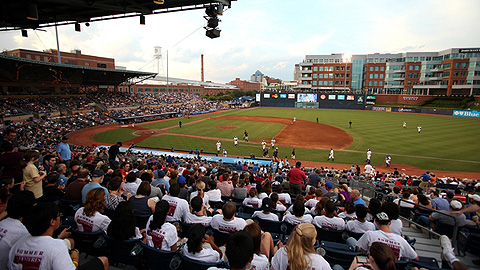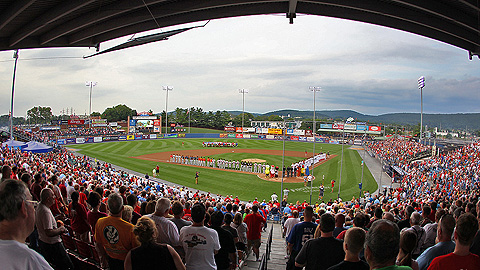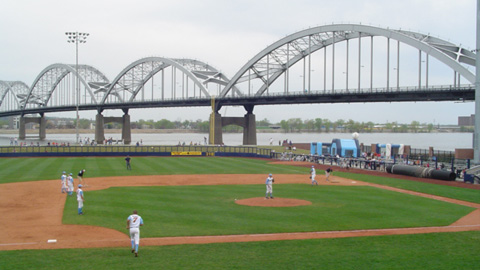Flashing back to best Minors stadiums
Over the past four seasons, I've traveled all over the United States (and Canada) in order to write about the unique fan experiences one can find at Minor League stadiums. I've sat in a dunk tank in Akron, dressed up as a racing molar tooth in Inland Empire, eaten scrapple in Delmarva, won a barrel of Cheese Balls in Trenton and lost a match against Port Charlotte's top sumo wrestler.
I still have a long way to go when it comes to achieving my ultimate goal of visiting all 159 Minor League ballparks (I'm about halfway there), but nonetheless I've seen a lot during my travels. And along the way, I've been asked the following question dozens upon dozens of times: "What's your favorite Minor League stadium?"
It's a logical question, but yet I've found it nearly impossible to answer. For how can I compare the rustic charms of places such as Burlington (Iowa or North Carolina, take your pick) with state-of-the-art urban facilities found in places like Memphis or Fort Wayne? And what factors should be used to determine my answer, anyway? By taking in all factors of the ballpark experience (food, parking, customer service, etc.)? Or simply evaluating the structure itself, in concert with the views it provides?
Despite the inherent nebulousness of such a task, I will nonetheless undertake it. After days of deep thought I have chosen the Top 10 Minor League stadiums I have had the good fortune to visit during my professional peregrinations. Please note that these 10 are presented randomly; choosing 10 was hard enough as it was, ranking them in order would be impossible.
Your opinions will, no doubt, differ from mine, and I want to hear them -- in the comments, on Twitter or via email. Let's keep this conversation going all the way until the season starts, at which point we can hopefully continue it at a Minor League stadium near you.
Durham Bulls Athletic Park (Durham Bulls, International League)

The Bulls' previous home of Durham Athletic Park lives on in the popular imagination due to its depiction in the iconic film Bull Durham, but the similarly named Durham Bulls Athletic Park is well on its way to classic status as well. Built in 1995, this sprawling multi-tiered facility is the centerpiece of Durham's revitalized "American Tobacco Historic District," a cluster of red-bricked industrial buildings repurposed for the 21st century as condos, offices, bars, restaurants and a museum. This thoughtful mixture of the past and present is the perfect backdrop for something as timeless as Minor League Baseball.
Everett Memorial Stadium (Everett AquaSox, Northwest League)
A quirky gem, Everett Memorial Stadium is owned by the local school district and neatly tucked into a low-key downtown environment. The stadium's interior is cozy, consisting of little more than a seating bowl and bleachers, and highlighted by some of the most aesthetically pleasing billboards to be found in Minor League Baseball. (Also aesthetically pleasing -- a no-frills manual scoreboard, complete with the exhortation to "Hit It Here. Win A Suit.") The concourse is located around the outside of the stadium, meanwhile, adjacent to high school athletic fields and offering plenty of room for concessions and souvenirs indulging and general wandering. Before leaving, make sure to find the sidewalk plaque commemorating the approximate landing spot of Ken Griffey Jr.'s first professional home run.
FirstEnergy Stadium (Reading Fightin' Phils, Eastern League)

You most likely won't find agreement among Reading fans regarding the recent decision to change the team's name to the "Fightin Phils," but consensus is far easier to find when it comes to the enduring appeal of FirstEnergy Ballpark. Built in 1951 but having undergone recent extensive renovations, the stadium retains its original seating bowl and dugouts and is steeped in Phillies lore. Reading has been a Philadelphia affiliate since 1967, and pictures of famous alumni line the walls of the narrow concourse. Beyond the first-base seating area, a literal carnival atmosphere prevails with food kiosks, game areas, a music stage, and of course, a mascot autograph signing area.
Jackie Robinson Ballpark (Daytona Cubs, Florida State League)
Jackie Robinson Ballpark earned its name as a result of hosting the legend's Montreal Royals during 1946 Spring Training, but these days it's the only Florida State League stadium NOT to host such preseason exhibitions. That makes all the difference really. Whereas most stadiums in the circuit are oversized and sterile as a result of having to cater to big league needs, Jackie Robinson Ballpark is an intimate throwback made all the more memorable thanks to Daytona's robust fan base and downright beachy environs. Ringing the stadium, amidst rows of palm trees and just a stone's throw from the water, is the interactive Jackie Robinson Museum. Tours of this outdoor learning area are self-guided, so get there early in order to have ample time to learn more about this memorable stadium's memorable namesake.
Modern Woodmen Park (Quad Cities River Bandits, Midwest League)

Formerly known as John O'Donnell Stadium, Modern Woodmen Park is in its ninth decade of existence, but has aged gracefully. Extensive renovations in recent years have certainly helped. But even without that boost, Modern Woodmen, located on the banks of the Mississippi River, would still be worthy of mention due to its stunning backdrop. Rising beyond the right-field fence are the interlocking arches of the Centennial Bridge, a beautiful structure that connects Davenport, Iowa, with Rock Island, Ill. This is one of the most spectacular views found in the Minors, and it's only going to get more spectacular. The River Bandits recently announced that a Ferris wheel and a Zip-line soon will be added to stadium grounds.
MCU Park (Brooklyn Cyclones, New York-Penn League)
I almost neglected to include MCU Park in this list, simply because I'm a Brooklyn resident and have come to take it for granted. But a visit to this facility is well worth the $2.25 subway ride, located as it is amidst the summertime wonderland that is Coney Island. The Atlantic Ocean lies beyond the outfield fence, the salty smell of which combines with Nathan's hot dogs (the original location of the franchise is just down the street) to create a unique olfactory experience. And then there are the visuals. MCU Park's light fixtures are ringed with neon, an appropriate addition to a beachside setting that already includes iconic amusements such as the Parachute, Wonder Wheel, and of course, the Cyclone roller coaster.
Dickey-Stephens Park (Arkansas Travelers, Texas League)

Though I regret never having visited the Travelers' previous home of Ray Winder Field, Dickey-Stephens Park amply celebrates the legacy of that historic facility while possessing plenty of its own unique charm. Begin your visit at the Travelers Baseball Museum (located on the concourse), which includes artifacts such as the vintage desk once used by legendary team president Bill Valentine. Then move on to Hook Slide Corner, a spacious and always-lively beer garden named in honor of a Travs fan who was known for sliding into a popcorn box on concrete while wearing jean shorts (really). Finally, wander past the outfield wall for a view of downtown Little Rock, including the Old State House where Bill Clinton celebrated his 1992 election victory.
Pensacola Bayfront Stadium (Pensacola Blue Wahoos, Southern League)

The Pensacola Blue Wahoos played their inaugural season in 2012, the success of which was largely contingent on spectacular Pensacola Bayfront Stadium. Perhaps the structure itself isn't spectacular, but its location is -- Pensacola Bay serves as the stadium's backdrop, and the expansive views of its sparkling deep blue water result in what is easily the most aquatic environment in all of Minor League Baseball. Combine this with the stadium's downtown location (bustling Pelafox Street is close by, and parking at the stadium is purposefully limited in order to maximize foot traffic) and Pensacola's long-standing propensity for partying and the end result is one of the most raucous and downright joyous baseball settings one could hope to find.
Nat Bailey Stadium (Vancouver Canadians, Northwest League)
Despite its distressing lack of affiliated professional teams, baseball passion is alive and well in Canada, and for proof of this, one only needs to visit Vancouver's Nat Bailey Stadium (home of the aptly named Canadians). Drenched in history and surrounded by mountainous splendor, this 61-year-old ballpark is a classic in every sense of the word. Beneath a covered grandstand that gives even the sunniest of days a dark-toned hue, fans pack themselves onto red wooden benches and commence to root for the home team with a vociferousness that would put most American fan bases to shame. This is baseball worth crossing the border for.
ONEOK Field (Tulsa Drillers, Texas League)

Tulsa's ONEOK Field, which opened in 2010, is an excellent example of setting a template for the future by looking to the past. The facility has played a key role in revitalizing Tulsa's once-thriving Greenwood neighborhood, with sidewalk plaques outside of the stadium commemorating the businesses that were destroyed in 1921's devastating race riots. Warehouses and other industrial landmarks are prevalent in the area, and firework displays must be coordinated so as not to disrupt the movement of the freight trains that chug through on tracks just beyond the outfield. Inside, one finds nothing less than a stellar example of a 21st-century ballpark, including a 360-degree concourse, splash zone, multi-tiered picnic area and concession options up to and including a build-your-own frozen yogurt station.
Benjamin Hill is a reporter for MLB.com and writes Ben's Biz Blog.